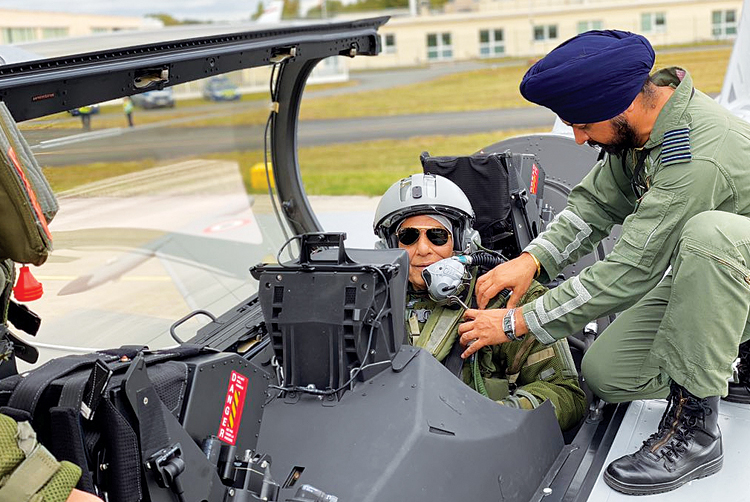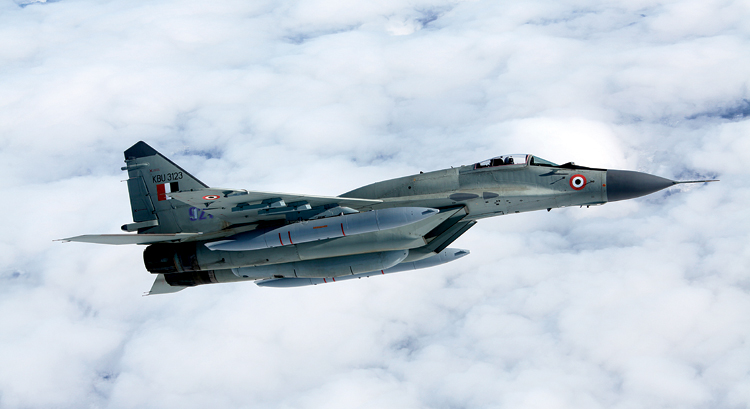INDIAN ARMED FORCES CHIEFS ON
OUR RELENTLESS AND FOCUSED PUBLISHING EFFORTS

SP Guide Publications puts forth a well compiled articulation of issues, pursuits and accomplishments of the Indian Army, over the years

I am confident that SP Guide Publications would continue to inform, inspire and influence.

My compliments to SP Guide Publications for informative and credible reportage on contemporary aerospace issues over the past six decades.
Fighter Strength Bottoms out at 29
No further depletion in number of operational squadrons if LCA Mk 1A and MRFA programmes kept on track, as the world’s 4th largest air force discards legacy Soviet-origin MiGs

The Indian Air Force (IAF) fighter aircraft strength appears to have bottomed out at 29 operational squadrons with the de-induction of the last of the Soviet origin MiG-27 ‘Flogger’ swing-wing fighter bombers on December 27.
No further depletion will take place in the IAF’s fighter strength over the next five years or so, and longer, if acquisition programmes for the indigenous Tejas Mk 1A and the new foreign-designed Multi-Role Fighter Aircraft (MRFA) are kept on track. The induction of the BrahMos-armed Sukhoi-30MKIequipped No. 222 Squadron at Thanjavur on January 20 – while still in the process of being populated to the authorised number of fighters – is the 30th operational squadron.
And while this is just about two-thirds of the IAF’s sanctioned strength of 42 squadrons to prepare for a two-front war, the hitting of the trough at 29 squadrons marks a big relief for the world’s fourth largest air force, which can now focus on making up the deficit of required numbers.
At the moment, the IAF numbers comprise 12 squadrons of its frontline Su-30MKI, 6 of the Jaguars, 4 of the MiG-21 Bison, 3 each of the Mirage-2000 and MiG-29UPG and 1 of the Light Combat Aircraft Tejas. The 13th Su-30MKI squadron at Thanjavur is work-in-progress.
The next round of de-inductions is due in 2024-25, when the vintage MiG-21 Bison fleet hits retirement. But the loss of four of MiG-21 Bison squadrons will be offset by the scheduled induction of 2 Rafale squadrons, and at least 1 more of both the LCA Mk 1 and the Su-30MKI. Also under negotiation is the acquisition of 1 additional MiG-29 squadron from Russia in a flyaway condition.
Former Chief of the IAF Air Chief Marshal Fali Major (Retired) sees the current situation as a significant but a temporary reprieve, and one which must be made use of to push the most important fighter procurement programmes. “This enables a status quo in numbers for the next four to five years. The longer-term situation depends upon the Multi-Role Fighter Aircraft (MRFA) and Light Combat Aircraft Tejas Mk 1A programmes being kept on track,” the former Air Chief inferred.
After the MiG-21 Bisons, the next fleet which will head for phase-out will be the Jaguar after 2030. The IAF has already scrapped its programme to re-engine the Jaguar deep penetration strike aircraft, which is present in significant numbers.
The next round of de-inductions is due in 2024-25, when the vintage MiG-21 Bison fleet hits retirement. But the loss of four of MiG-21 Bison squadrons will be offset by the scheduled induction of 2 Rafale squadrons, and at least 1 more of both the LCA Mk 1 and the Su-30MKI.
To keep up the desperately required numbers, the role and performance of the government-owned Hindustan Aeronautics Limited (HAL) will be vital. The contract for 83 LCA Mk 1A fighters is likely to be signed early in the Financial Year 2020-21. HAL will be required to commence delivery three years after contract, and has received Government funding to augment the Tejas assembly line to ramp up production rate to 16 fighters a year.
Even more significant will be the outcome of the process to acquire 114 MRFA under the Strategic Partnership Model which seeks to establish a private sector Defence Industrial complex. Under Chapter 7 of the Defence Procurement Procedure, the Ministry of Defence will shortlist eligible Indian private sector companies and foreign OEMs in separate evaluations. Tenders will be issued to the shortlisted Indian companies, each of which will be required to submit a bid in partnership with a shortlisted foreign OEM to enable deep transfer of technology for the ‘Make in India’ programme. The field for the competition could include the French Dassault’s Rafale, the European consortium’s Eurofighter, Boeing’s F/A-18 Super Hornet and Lockheed Martin’s F-21 from the US, Russia’s Sukhoi-35 and MiG-35 and Swedish Saab’s Gripen. The IAF seeks proven 4.5 Generation capability through this acquisition.

The re-shaping of India’s fighter fleet would also mark the drawdown of the famed MiG variants. After the impending decommissioning of the MiG-21 Bison, the only variant from the Mikoyan Gurevich design bureau to be flown by the IAF will be the MiG-29UPG, 3 squadrons of which are there in the IAF inventory. Another 2 squadrons of the MiG-29 deck-borne fighters are flown by the Indian Navy.
The MiG drawdown is a very significant milestone because it was for decades the overwhelming mainstay of the IAF fleet. Publicly available figures suggest that the IAF has flown over 1,400 MiGs. Since it was first inducted in 1963-64 in the IAF’s 28 Squadron as India’s first supersonic fighter, hundreds of MiG-21s have been license-produced in India. The swing-wing MiG-23s were acquired in flyaway condition while an estimated 165 of its later variant, the MiG-27 was produced under license in India. The IAF also operated a squadron of the MiG-25 ‘Foxbat’, the world’s fastest fighter which flew on the edge of space, for reconnaissance. The MiG-29 air superiority fighters have been converted into multi-role fighters with upgrades, which make these platforms relevant for at least another decade.
The phase out of the MiG-27 was marked both by nostalgia and relief. While it provided India with ground attack capability at very economical terms a time when India had very limited options for sourcing military supplies, the ‘Flogger’ was also one of the most crash-prone fighters of the IAF because of a flawed engine. Long decommissioned by Russia, its maintenance and sustenance was also a challenge. The only Air Force still flying this antiquated fighter is Kazakhstan’s.
As it positions itself for overcoming the technology handicap legacy, the IAF would still be hobbled by the compulsion to operate six different fighter types, even after the MiG-21 Bison flies into the sunset.





